Louis Theroux: Looking back on Jimmy Savile
- Published
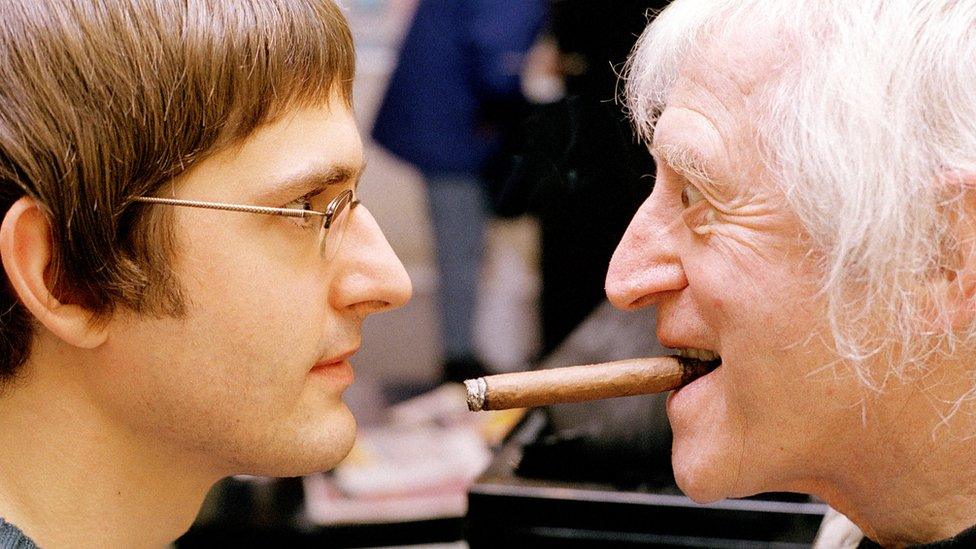
I was at my wedding in July 2012 when I learned that the DJ and TV presenter Jimmy Savile was to be unmasked as a sexual predator in an upcoming ITV documentary.
At that time, I imagined I knew Savile reasonably well. I'd made my own documentary about him in 2000, filming with him for about two weeks at his various homes around Britain.
I'd stayed in contact for several years after the film went out, making occasional trips up to Leeds. There was always a professional pretext - a DVD commentary to record, a new series to promote - but the visits also had a social dimension.
They usually involved a meal at a local restaurant and sometimes an overnight stay at his penthouse overlooking Roundhay Park. We had a friendly relationship.
The Jimmy Savile I knew then was a contradictory figure. In some respects, he was enigmatic and slightly remote, hiding behind his show-business patter and anecdotes.
There was scant sign of any sort of love life. He was insular. Social events were on his terms - he had to be the centre of attention. He was also prone to dropping the occasional dark hint of unconventional interests - he'd make tantalising references to his connection with Myra Hindley, or joke about his visits to Broadmoor and his conversations with Peter Sutcliffe.
But Savile could also come across - and it's not easy to write this now - as a rather likeable person, good-humoured, knowledgeable, "un-starry" in his manner of life and in his friendships with local Leeds characters. His self-centredness had the effect of making him undemanding company - he was relaxing to be around.

Find out more
Louis Theroux revisits his encounter with Jimmy Savile
Louis Theroux's documentary on Jimmy Savile is broadcast on Sunday 2 October at 21:00 on BBC Two - catch up on BBC iPlayer

One of my reasons for keeping in touch was that I was aware I hadn't quite figured him out. For a while I kept notes for a book I thought I might write one day that would try to unravel who he was.
Sometimes he mentioned girlfriends coming to visit, but I was never quite sure how much of that to believe. In 2001, a year after my documentary went out, I met two women, then in their forties, who told me they'd been girlfriends of his decades earlier.
One of them had been 15 at the beginning of the relationship. I mentioned it to colleagues at work - but to be honest, I didn't think a great deal of it, seeing it as symptomatic of a different time.

Publicity shot from the 2000 documentary When Louis Met Jimmy
I'd last seen him in 2006. When he died, five years later, I wrote a blog post, expressing a sense of guilt about not having visited him towards the end. "He was a complete one-off," I wrote. "Wrestler, charity fundraiser, deejay, fixer, prankster, and professional enigma."
We are still, as a society, attempting to recover from the reverberations begun by that ITV documentary, and the tsunami of revelations that followed from it.
The accounts of the victims are written up in a collection of reports issued by the BBC, various police forces, and several NHS hospitals. They number in the hundreds, and include multiple instances of rape and child molestation.
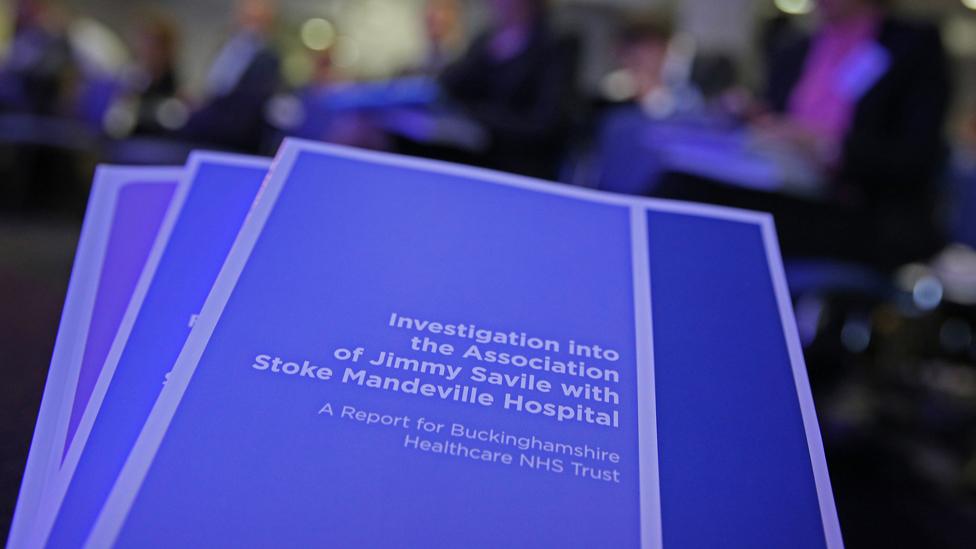
A 2015 report into Savile's activities at Stoke Mandeville Hospital
Those revelations, in turn, have sparked a wave of investigations into other well-known figures, some of whom have also been found guilty of sex crimes - Max Clifford, Rolf Harris, Chris Denning and Gary Glitter.
Meanwhile, those people who were friendly with Savile have had to come to terms with the role he played in their lives.
For my own part, that has involved a process of taking stock - attempting to piece together what I knew of the man and how it fits with the accounts of the victims.
Late last year, I began doing this in a more concerted way as part of a follow-up TV documentary. I interviewed victims. I also spoke to other people who knew him - friends and colleagues, some of whom worked alongside him for decades.
In the process I tried to form a picture of who Jimmy Savile was and how someone known to millions for his programmes and his charity work had, over several decades, got away with a catalogue of crimes.

Savile in 1981 with Radio 1 colleagues, talking to the Duke of Edinburgh during a charity bed push
Behind all of this there was a more personal mission - to figure out my own role in the affair and whether I was, in some way, "played"?
Now, after the revelations, any effort to tackle Jimmy Savile has to have at its heart the experience of the victims.
For years they were invisible - finally they have a voice.
Just the act of approaching them felt fraught. In the usual way of making documentaries, it's fairly normal to interview someone and then not use the interview in the finished film.
Here we were aware that the act of "going public" and then having the interview dropped could be traumatic.
My director, Arthur Cary, and his assistant producer, Rachel Lob-Levyt, made contact with the lawyer handling the victims' claims of compensation.
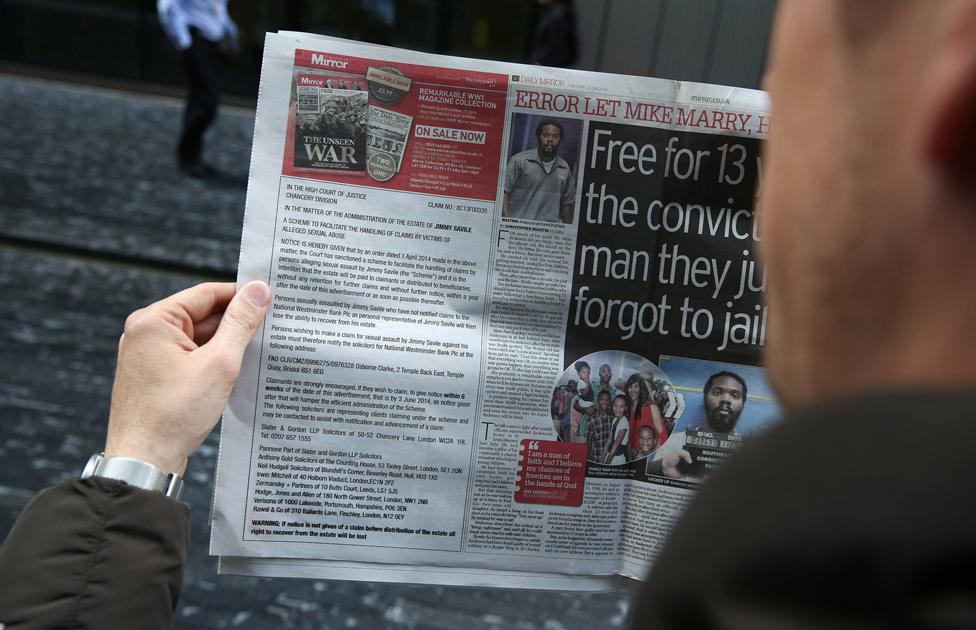
April 2014: A newspaper advert advises Savile's victims how to claim for compensation
Through her, we quickly got the sense that among the many victims there were some willing to share their stories - indeed, having been unheard for so long, they were pleased to have an opportunity to speak out.
We ended up using interviews with four victims in our finished documentary, all of them on camera and identifiable.
Speaking to them was, for me, a delicate and slightly nerve-wracking experience.
In my work, I've tended to focus on the perpetrators of violence and abuse. I felt more pressure handling those on the receiving end of assault. I wasn't sure how difficult it would be for them to open up about their experiences.
I was also aware they might see me as yet another person who failed them, by not doing more to expose Jimmy Savile while he was alive.
In fact, it ended up being both personally cathartic and also highly revealing.
Each of them had a dignity and a quiet courage, speaking with total candour about what she'd been through - the abuse followed by the long years of knowing that a predator was lodged prominently in British public life.
Savile's victims came from all walks of life, all ages, male and female. But there were certain patterns to his offending.
More than anything he had an uncanny instinct for vulnerability. Two of the women I spoke to had already been abused by family members by the time they encountered Savile.
As one of them put it to me, she viewed the assaults as just "what men do".
His ability to target the defenceless - teenagers in care, patients recovering in hospital, children from troubled homes - helps explain why he wasn't caught.
They were the least likely to resist; they were also least likely to be listened to.
The youngest of the victims I spoke to had been abused by her grandfather from her earliest childhood before being molested by Savile on multiple occasions in the chapel at Stoke Mandeville.
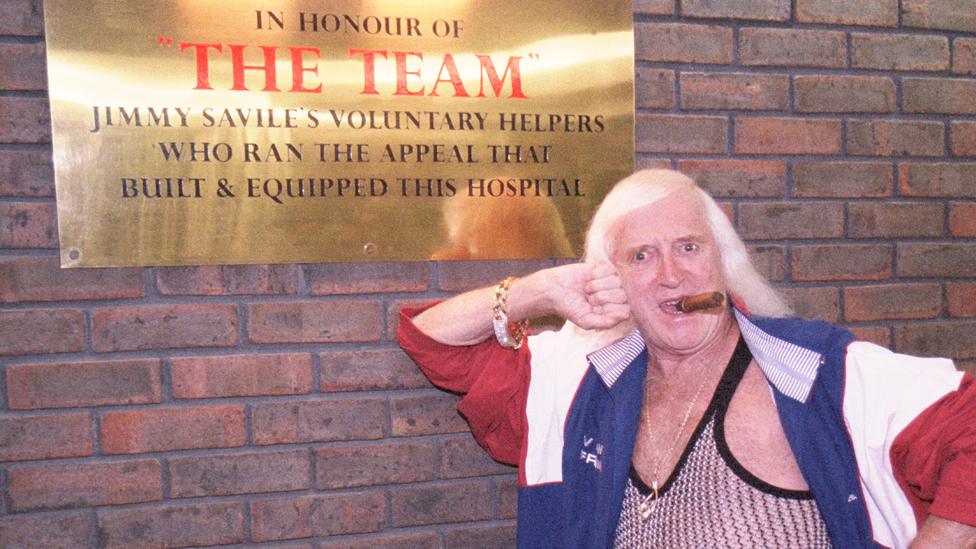
A report found that Savile had abused 63 people at Stoke Mandeville Hospital
"I never said to him 'Don't'," she told me, "because I knew he could."
What also came across was the brazenness of his assaults. One of the women described how she'd been delivering a new pair of spectacles to his house.
He exposed himself to her and stuck his tongue in her mouth. Moments later, he'd asked if she'd like to do an interview for his radio show, Savile's Travels, before driving her home in an open-topped car.
Jimmy Savile seems to have understood that by sheer gall - and by being utterly shameless - he could project a sense of permission. The message to his victims was: I'm a star, this is normal, I can do whatever I want.
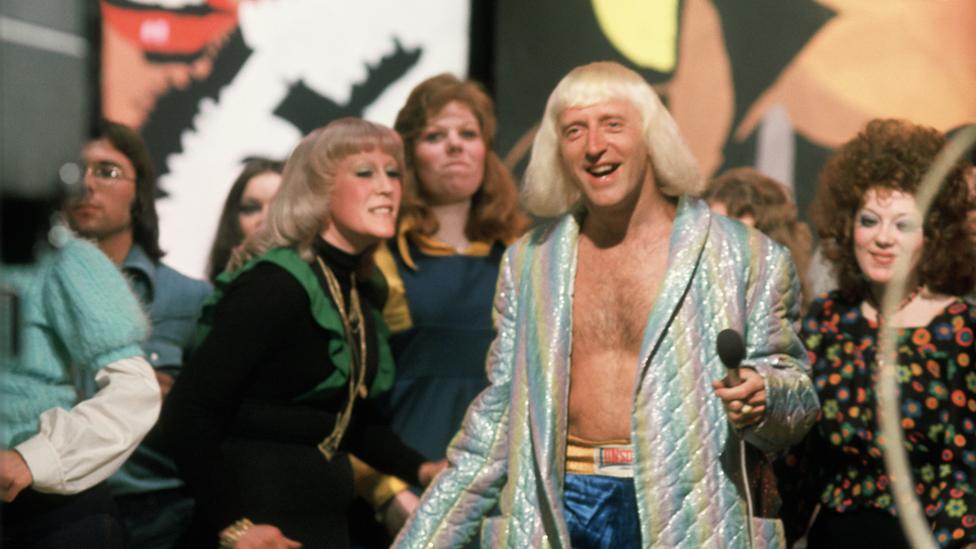
Savile: "By being shameless he could project a sense of permission"
Perhaps most heartbreakingly, several victims expressed regret over a self-perceived (and wholly unjustified) sense of failure to speak out. They thought it was just them. If only they'd known there were others, they said, they would have done something to stop him.
With all the victims, there was the slightly uncomfortable moment of soliciting their opinions on my original documentary.
It was oddly bracing to feel the force of their unvarnished feedback. "I remember thinking 'Poor Louis'," said one. She said she felt I'd been "hoodwinked" by him. Another remarked on how "silly" I seemed, being pushed around by a puffed-up celebrity.
It is fair comment. At the time, I'd done my best to be tough with him. I knew he was weird and, with all his mannerisms, rather irritating - I had no interest in making a soft piece about Jimmy the Charity Fundraiser.
The dark rumours - of sexual deviance, of being unemotional, of having a morbid interest in corpses - were one of the reasons I'd taken him on as a subject.
I wanted to get the goods on Savile. The trouble was, I had no clear sense of what those goods were.
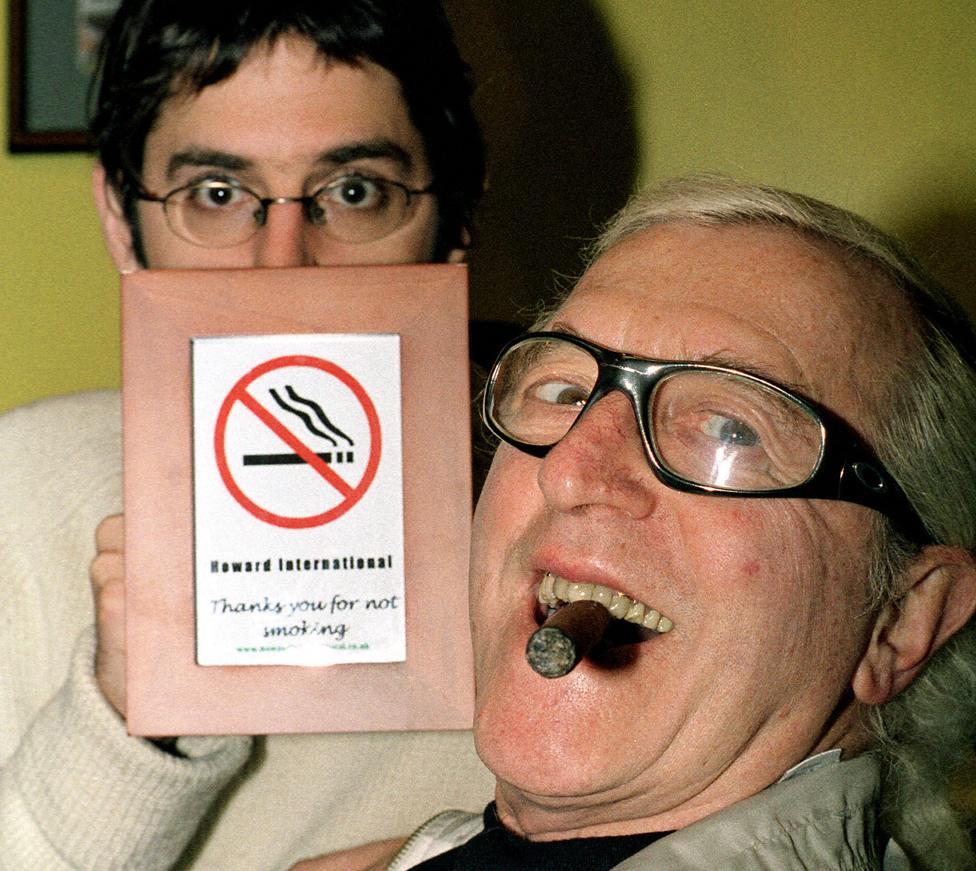
The first couple of days of filming had been a torrent of Jimmy Savile blather:
"Is that the Spice Girls?"
"You're better looking than me, you can't come in."
"I am like a butcher's dog… there's nothing fitter or stronger."
He'd given me free range of his penthouse. I pulled random letters and memorabilia off his desk. I tried to break up his spiel - I brought up a recent article in the Daily Mail, entitled "Jim Fixed Me", in which his long-time personal assistant talked about the pain of being summarily fired.
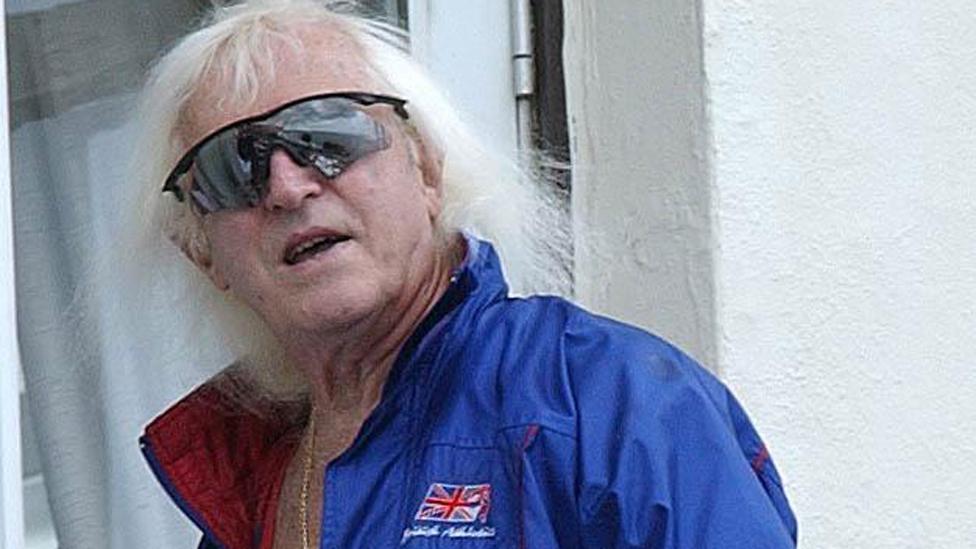
Savile at his flat on the Scarborough sea-front
He tolerated my questions and interjections with relatively good grace until, several hours in, he showed signs of losing his patience: "It's a lot easier to make negative programmes than positive ones," he said.
I explained that we weren't trying to make a positive programme so much as a truthful one. "Right. Make it as negative as you like. That's all right. See you in court. Take a few quid off you same as I take a few quid off anybody. Money has no conscience."
My most resolute attempt to figure out his secret came on a visit to the seafront flat he shared with his mother, The Duchess. He'd shown me some personal effects of hers that he still kept in a wardrobe, including the clothes he got dry-cleaned once a year.
As I leafed through a collection of old photographs, some showing him with his arms around various girls, I attempted to nail him down on the subject of his sexual interests.
Why, in the whole time he'd been in the public eye, had he never been linked with anyone in the papers? I asked.
"I think it's because I've never been linked to anybody," he said. Had he never had a girlfriend? "Friends that are girls, eight million," he replied. "Friends that are girls. But girlfriend in the sense of today, i.e. you are together, you don't bother with anybody else, etc? No. Never."
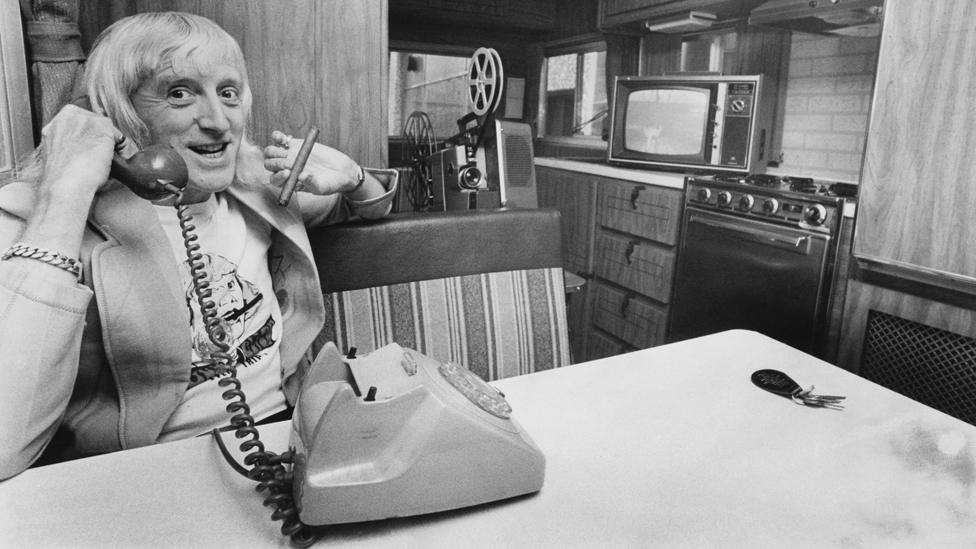
Savile in one of his caravans "living a vagabond existence"
He seemed to be presenting a rather improbable scenario of himself as an itinerant Don Juan with paramours all over Britain, all of them somehow flattered by the attention of an aged DJ in a tracksuit. It didn't add up.
On one of our last days of filming, we discussed the rumours of paedophilia. I had asked him why he always said in interviews that he didn't like children.
"We live in a very funny world," he said. "And it's easier for me, as a single man, to say 'I don't like children', because that puts a lot of salacious tabloid people off the hunt."
"Is that basically so the tabloids don't pursue this whole is he or isn't he a paedophile line?" I asked.
"Oh, aye," he said. "How do they know whether I am not? How does anybody know whether I am? Nobody knows whether I am or not. I know I'm not… That's my policy and it's worked a dream."
Louis Theroux questions Jimmy Savile about 'paedophile' allegations
At the time, it hadn't struck me as a particularly revealing exchange.
And yet, with hindsight, it's also interesting now much Jimmy Savile told us about himself. One of his constant themes was his view of women as "brain damage".
He said he didn't have a cooker in his Leeds penthouse because cookers attract women and women "equal brain damage…No cooker, babe, no brain damage."
It was passed off as a bit of banter but there was also an underlying truth. In Savile's view, women were overly emotional and illogical. He wasn't interested in the give-and-take that relationships entail. What he left out was his solution - to take what he wanted, without consent and with impunity.
Savile's relationships, with men and women, were conducted on his terms. He expected loyalty, but did not like being at the beck and call of others.
Travelling between his houses, living in his caravan, going on his cruises, he led a vagabond existence, a little like the wild animals he sometimes compared himself to.
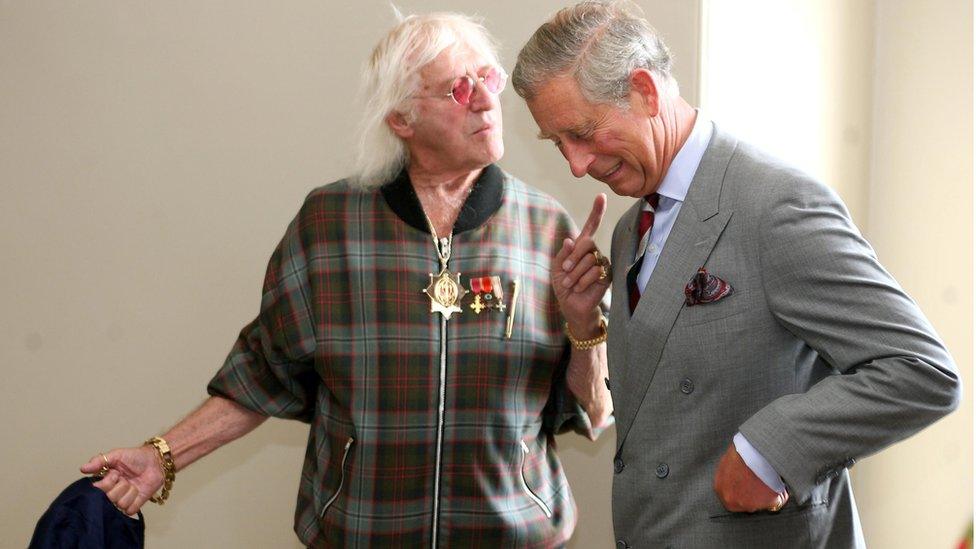
With Prince Charles - Savile "would make constant references to friends in high places"
He would also make constant references to his friends in high places - the Royal Family, in particular - while also advertising his absolute discretion. "Omerta", he said, when I asked about his relations with the powerful. "When you're not a grass, you're not a grass."
But this code of secrecy and loyalty pervaded his relationships in general. He described himself as being like a mafia boss. "The Godfather… il capo di tutti capi." There were references to "friends with strong Sicilian accents".
Again, it came off sounding faintly ludicrous - it was a bit of comic schtick. Or was it?
Late one night, in an unguarded moment after I'd gone to bed, he reminisced to my director Will Yapp about his days running nightclubs in the north. He wouldn't stand for any nonsense, he said.
Anyone who gave him trouble, he'd lock them in his "boiler house". They'd be there all night "pleading to get out". The police had questioned him, but he'd talked his way out of it: "I never got nicked, and I've never altered."
Even allowing for bravado, there was a ruthlessness and a sangfroid which was startling. And it couldn't but call to mind the one time we know of when, in the late 2000s, the Surrey police questioned him about historical sex offences but failed to pin him down.
Savile's personal assistant once said that he didn't have many close friends. "He found friends an encumbrance."
Nor of course did he have a family of his own.
A self-described expert on human psychology, he liked to say that, through his mental strength and his ability to live without normal human relationships, he had created for himself a life of "total freedom".

But Jimmy Savile did have many people with whom he had friendly relations. They were people from all walks of life. Some would qualify as the great and the good - hospital heads, surgeons, top TV producers.
Others, the ones he saw more regularly, were down-to-earth types, uncomplicated Leeds men: a hairdresser, a chemist, a policeman. We'd featured a few of these in my first documentary.
When the time came to try to speak to them again I discovered, perhaps not surprisingly, that many of them felt too confused and embattled to go public.
Their association with Savile had been a source of pride while he was alive. Now it had become a source of embarrassment and fear.

Investigating Jimmy Savile: A brief timeline

Savile's funeral in November 2011 at Leeds Cathedral
29 October 2011: Jimmy Savile found dead at his home in Leeds; he is buried the following month in Scarborough
December 2011: A BBC Newsnight investigation into abuse allegations is dropped
3 October 2012: ITV airs an investigation, Exposure, The Other Side of Jimmy Savile in which several women allege he sexually abused them
9 October 2012: Police announce launch of Operation Yewtree, to investigate allegations against Savile
11 Jan 2013: Joint report by Metropolitan Police and the NSPCC says they have recorded 214 offences; offences took place at many locations including hospitals and a hospice
26 June 2014: Department of Health publishes the result of investigations by 28 medical establishments; Savile found to have abused 60 individuals at Leeds General Infirmary
26 February 2015: Separate report into Savile's activities at Stoke Mandeville Hospital finds that he sexually abused 63 people there
25 February 2016: Dame Janet Smith's report into Jimmy Savile at the BBC says the corporation missed opportunities to stop "monstrous" abuse because of a "culture of fear"

Those who did speak to us were all in different ways grappling with the aftershocks of the revelation of what Savile did.
A BBC producer told me that in all the years she worked alongside him at Clunk Clink, Jim'll Fix It and Top of the Pops, she never saw anything that caused her concern.
I asked if she'd read the reports. No, she said. "Because I don't know what I'd do with it".
She'd had no real sense of his private life, though looking back little clues stood out.
"Part of his persona was the fact that he would tread very close to the line in hindsight."
And she mentioned, when I asked if he'd never shown anything other than a professional interest in her, that she would have been too "walnuttish" for him - a word she'd heard him use. She was then in her mid-20s.

Dame Janet Smith's report into Jimmy Savile at the BBC was delivered in February 2016
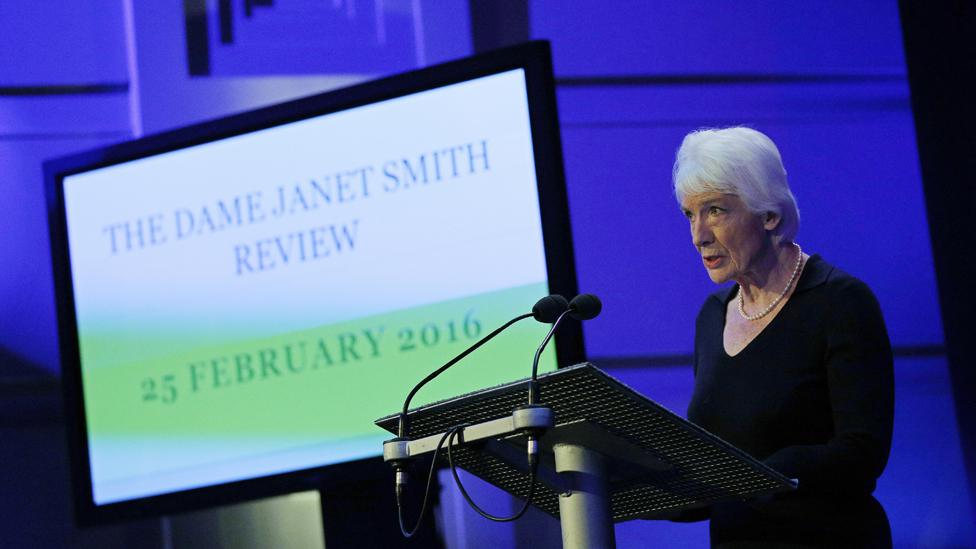
These are some of the key findings:
At least 72 people were sexually abused by Savile in connection with his work at the BBC, including eight victims who were raped; the youngest rape victim was 10 years old
The offending took place from 1959 to 2006, mostly in the 1970s
The largest number of victims was in connection with Savile's work on the BBC's Top of the Pops programme
The culture of the BBC enabled Savile's offending to go undetected for decades
The BBC missed at least five opportunities to stop the abuse

A colleague at Stoke Mandeville had a trove of memorabilia, including pictures, an over-sized last birthday card that was never given to him, and a larger-than-life Jimmy Savile bust made out of Lego, which she kept in the shed.
She'd spent the greater part of her working life raising money for Stoke Mandeville's Spinal Injury Unit. All that work was now tarnished and rendered suspect. She spoke of the upset of feeling that her life's memories were at risk of being lost.
And then there was Jimmy Savile's personal assistant, the one he'd jettisoned so unceremoniously. She had worked as Savile's diary-keeper and factotum for more than two decades.
By her own account, she organised events, cooked for him, and covered for him when necessary. When he'd felt lonely on a round-the-world cruise because it was full of Americans, none of whom recognised him, she'd spoken to him on the ship's phone every day to keep his spirits up.
Then, without explanation, he'd sacked her, saying simply: "She's out."
Her view of Jimmy Savile had been that he was "asexual".
She had read the reports, she told me. But she viewed the incidents described as either trivial ("a pat on the bum" as she put it) or simply made up.
Like the colleague at Stoke Mandeville, her life work had been tainted from its association with Jimmy Savile. Her way of dealing with it was simply to refuse to acknowledge the truth.
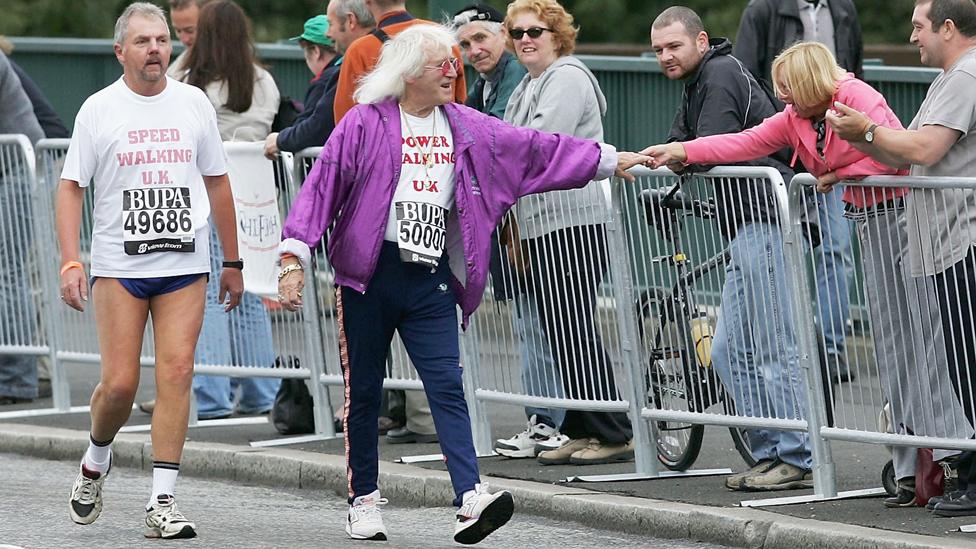
Savile taking part in the Great North Run in 2004
Re-entering the world of Savile was like travelling across a landscape ravaged by a hurricane. The survivors were making sense of what happened in different ways, but no one was untouched by what they had lived through.
Among those I reached out to were the two girlfriends I'd met in 2001.
At the time of the revelations, they'd come forward to say that they too had been abused by Savile. It was troubling to realise that I'd spoken to two victims while he was still alive. I wondered whether, if I'd handled the encounter differently, they might have been able to say more.
Those two women still didn't wish to talk publicly about what they had been through but they agreed to have a private meeting with me.
They spoke about the rumours of his connections to the underworld. They said that, as much as they wished he could have faced justice, they would have been too afraid to go to the police while he was alive.
For many, the easiest shorthand explanation of Jimmy Savile has been that "he hid in plain sight".
This was true in one sense. Savile had played up to an image as a white-haired playboy bachelor. "Feared in every girl's school in the country," he used to joke.
His sartorial style - tracksuits, jewellery, weird hair - was a statement of a kind of perpetual agelessness. He looked a little creepy. He wrote about borderline criminal sexual shenanigans in his autobiography, As It Happens, including a night he spent with a girl who was a runaway from a remand centre.
But a big part of his life was a kind of double bluff. Referring to himself as a "pirate" or a "con man", as he often did, served to reassure those around him that he couldn't really be those things - or at least, not in a way that we should worry about.
His need to be seen to have secrets suggested perhaps his secrets weren't worth knowing - that it was simply another bid for attention.
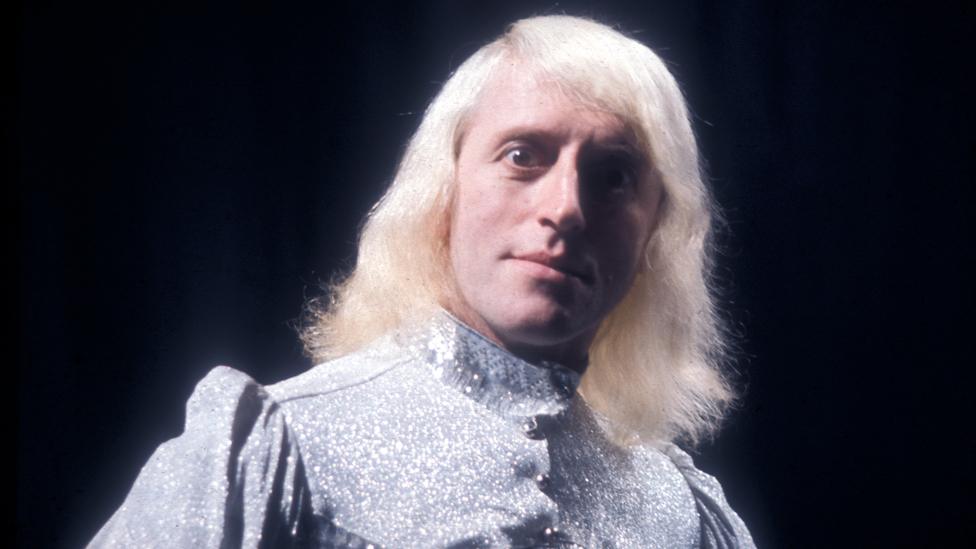
"Savile had an ability to work a room, almost like a stage hypnotist"
"His big secret was that he had no secret," was one of the comments in the days after he died.
If only.
In fact, Jimmy Savile's offending took place both in plain view and also out of sight - and it was his blurring the lines that was part of the MO.
Victims who'd been groped and complained were told, that's just Jimmy. Some who were groped with other people near at hand felt unable to protest. They wondered if this was, somehow, permitted.
Reading the reports of the assaults, it was clear Savile had an ability to work a room, almost like a stage hypnotist working an audience.
Many of his assaults involved him testing the limits of what he could get away with. He would push the boundaries, starting off in a grey area so that sexual assaults weren't immediately recognised as such.
Still others were assaulted away from prying eyes - at his flat, in his caravan. Some took the understandable decision that to report the assault would lead to a process that would in its own way be traumatic.
Others tried to raise the alarm but weren't listened to - by colleagues, friends, parents or those in charge.

The impact of the Savile case on child abuse allegations
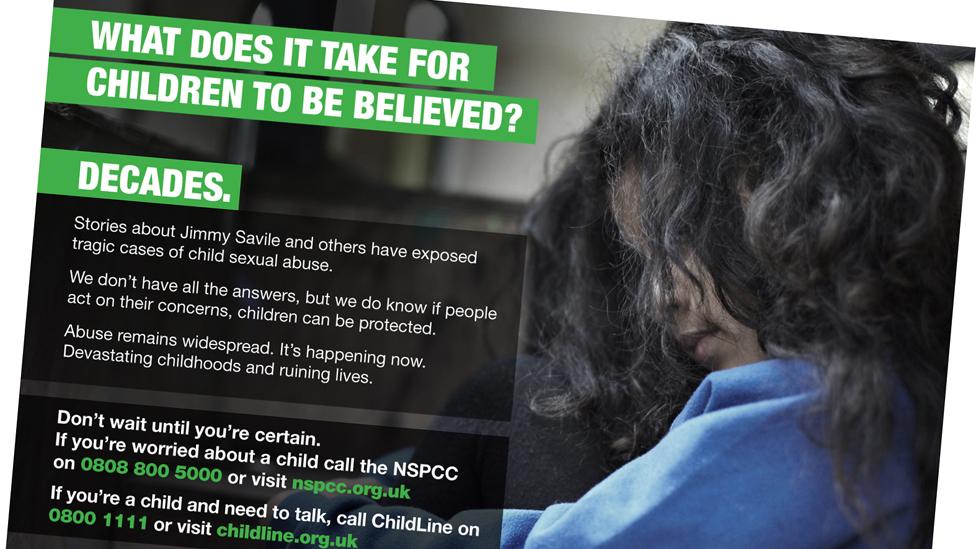
Since Jimmy Savile's death in 2012, a number of well-known men have been prosecuted for historic sexual assault and rape allegations; the entertainer Rolf Harris, TV presenter Stuart Hall and celebrity publicist Max Clifford were all convicted
Chief Constable Simon Bailey, the National Police Chiefs' Council's lead on child protection, said in May 2015 that police were projected to receive about 116,000 reports of historical child sex abuse by the end of that year - an increase of 71% from 2012
He said: "There is no doubt Savile has had an effect on us. We are dealing with more and more allegations."

In hindsight, it's tempting to see clues everywhere.
In a random comment on a recce tape - when our production first sent an assistant producer to interview him he referred to his bed as an altar, because that's where the "sacrifices" happen, he said.
Or in the overly physical way he embraced two women at Leeds's Flying Pizza restaurant one evening, which I only noticed looking back at the rushes.
Or in his comment to me on one occasion that "a psychologist will tell you" that there was something in all women "that wants to be a prostitute".
But given what we've lived though, what is most difficult to explain is that most of the time Jimmy Savile behaved something like a plausible, albeit odd, person.
This may seem a rather banal point to make but it is also arguably the most frightening one. By making Savile a figure of almost supernatural evil - someone who was self-evidently repulsive and dangerous - we risk failing to see him clearly as a human being.
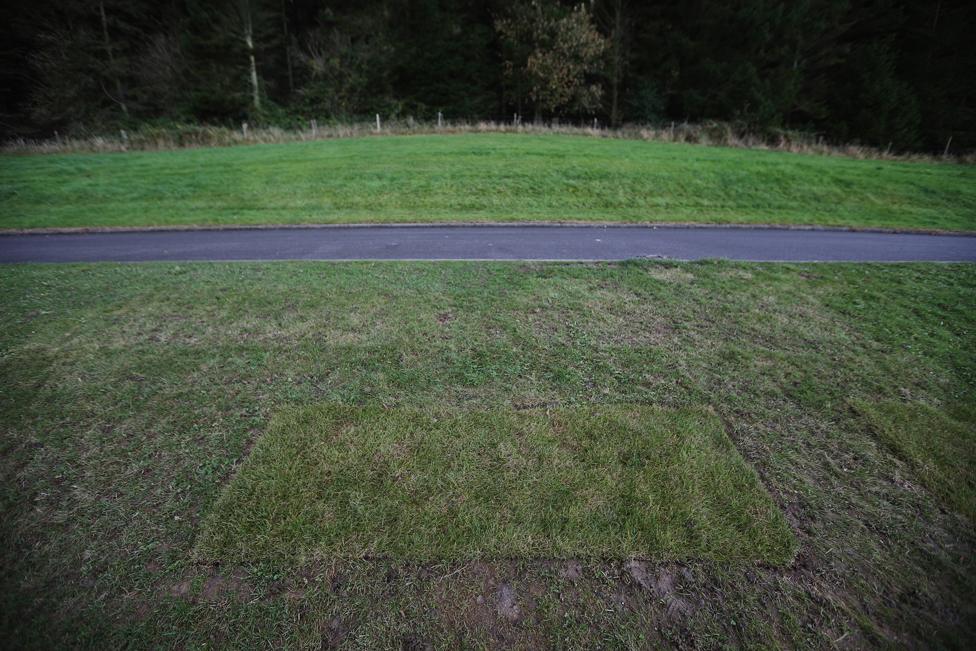
Savile's unmarked grave in a Scarborough cemetery
One day another Jimmy Savile may come along and he too may appear plausible - right up until the moment he is unmasked.
A human being did Savile's crimes - one who charmed princes, prime ministers, leading religious figures and celebrities, not to mention the millions of people who listened to him on the radio and watched him on television.
A human being who was intelligent, sometimes amusing, and likeable, and who, by being those things, was able to fool a nation.

Information and help for those affected by child abuse
The National Society for the Prevention of Cruelty to Children (NSPCC), external specialises in child protection
National Association for People Abused in Childhood, external offers support, advice and guidance to adult survivors of any form of childhood abuse

Join the conversation - find us on Facebook, external, Instagram, external, Snapchat , externaland Twitter, external